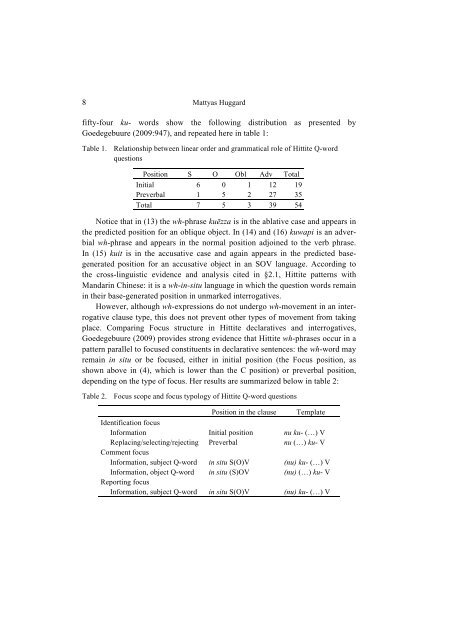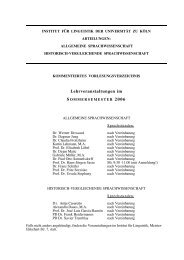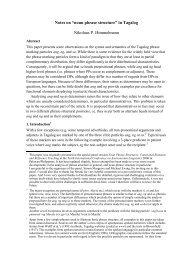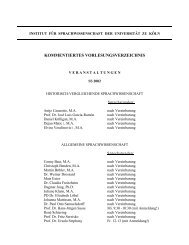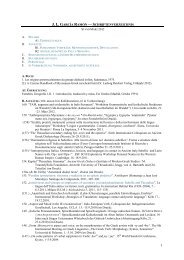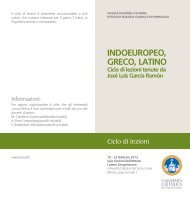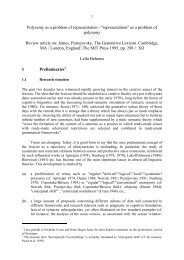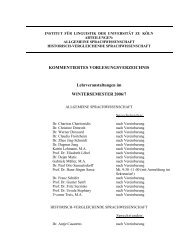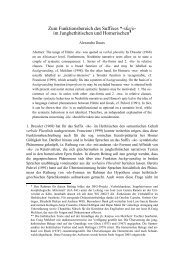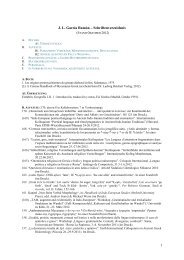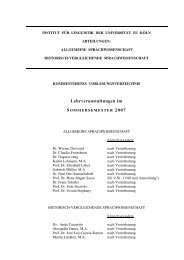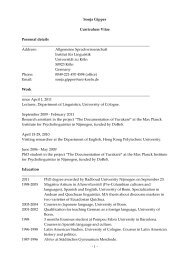Topics in Anatolian Historical Grammar Prof. Dr. H. Craig Melchert
Topics in Anatolian Historical Grammar Prof. Dr. H. Craig Melchert
Topics in Anatolian Historical Grammar Prof. Dr. H. Craig Melchert
You also want an ePaper? Increase the reach of your titles
YUMPU automatically turns print PDFs into web optimized ePapers that Google loves.
8<br />
Mattyas Huggard<br />
fifty-four ku- words show the follow<strong>in</strong>g distribution as presented by<br />
Goedegebuure (2009:947), and repeated here <strong>in</strong> table 1:<br />
Table 1. Relationship between l<strong>in</strong>ear order and grammatical role of Hittite Q-word<br />
questions<br />
Position S O Obl Adv Total<br />
Initial 6 0 1 12 19<br />
Preverbal 1 5 2 27 35<br />
Total 7 5 3 39 54<br />
Notice that <strong>in</strong> (13) the wh-phrase kuzza is <strong>in</strong> the ablative case and appears <strong>in</strong><br />
the predicted position for an oblique object. In (14) and (16) kuwapi is an adverbial<br />
wh-phrase and appears <strong>in</strong> the normal position adjo<strong>in</strong>ed to the verb phrase.<br />
In (15) kuit is <strong>in</strong> the accusative case and aga<strong>in</strong> appears <strong>in</strong> the predicted basegenerated<br />
position for an accusative object <strong>in</strong> an SOV language. Accord<strong>in</strong>g to<br />
the cross-l<strong>in</strong>guistic evidence and analysis cited <strong>in</strong> §2.1, Hittite patterns with<br />
Mandar<strong>in</strong> Ch<strong>in</strong>ese: it is a wh-<strong>in</strong>-situ language <strong>in</strong> which the question words rema<strong>in</strong><br />
<strong>in</strong> their base-generated position <strong>in</strong> unmarked <strong>in</strong>terrogatives.<br />
However, although wh-expressions do not undergo wh-movement <strong>in</strong> an <strong>in</strong>terrogative<br />
clause type, this does not prevent other types of movement from tak<strong>in</strong>g<br />
place. Compar<strong>in</strong>g Focus structure <strong>in</strong> Hittite declaratives and <strong>in</strong>terrogatives,<br />
Goedegebuure (2009) provides strong evidence that Hittite wh-phrases occur <strong>in</strong> a<br />
pattern parallel to focused constituents <strong>in</strong> declarative sentences: the wh-word may<br />
rema<strong>in</strong> <strong>in</strong> situ or be focused, either <strong>in</strong> <strong>in</strong>itial position (the Focus position, as<br />
shown above <strong>in</strong> (4), which is lower than the C position) or preverbal position,<br />
depend<strong>in</strong>g on the type of focus. Her results are summarized below <strong>in</strong> table 2:<br />
Table 2. Focus scope and focus typology of Hittite Q-word questions<br />
Position <strong>in</strong> the clause Template<br />
Identification focus<br />
Information Initial position nu ku- (…) V<br />
Replac<strong>in</strong>g/select<strong>in</strong>g/reject<strong>in</strong>g Preverbal nu (…) ku- V<br />
Comment focus<br />
Information, subject Q-word <strong>in</strong> situ S(O)V (nu) ku- (…) V<br />
Information, object Q-word <strong>in</strong> situ (S)OV (nu) (…) ku- V<br />
Report<strong>in</strong>g focus<br />
Information, subject Q-word <strong>in</strong> situ S(O)V (nu) ku- (…) V


